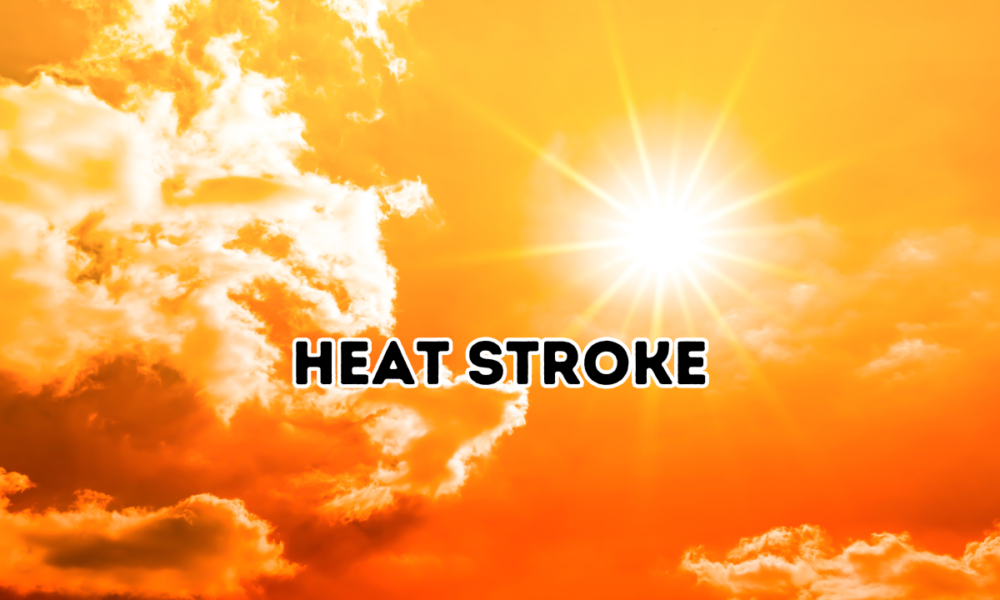What is Heat Stroke?
Heat stroke, also known as sunstroke, is a severe form of hyperthermia that occurs when the body overheats and is unable to cool down. This condition results when the body’s temperature regulation system fails, leading to a rapid increase in body temperature, often exceeding 104°F (40°C). Unlike heat exhaustion, heat can cause permanent damage to the brain and other vital organs and can be fatal if not treated promptly.
Symptoms of Heat Stroke :
Recognizing the symptoms of heat stroke is crucial for immediate intervention. Key symptoms include:
High Body Temperature: A core body temperature of 104°F (40°C) or higher is considered extremely high and can be indicative of severe conditions such as heatstroke or infection. Immediate medical attention is required.
– Altered Mental State or Behavior: Confusion, agitation, slurred speech, irritability, delirium, seizures, and, in severe cases, coma.
– Nausea and Vomiting: Feeling nauseous and vomiting.
– Flushed Skin: Red, hot, and usually dry skin, although if heat stroke is caused by exertion, the skin may be moist.
– Rapid Breathing and Heart Rate: Accelerated breathing and a strong, rapid pulse.
– Headache: Often severe and throbbing.
Causes and Risk Factors:
Stroke can occur in various situations, typically related to high environmental temperatures and physical activity.
– Environmental Heat Exposure: Prolonged exposure to hot and humid weather, especially during heatwaves.
– Strenuous Activity: Physical exertion in high temperatures, such as exercising or working outdoors.
-Dehydration: Inadequate fluid intake impairs the body’s ability to sweat and regulate temperature effectively.
– Inadequate Cooling Mechanisms: Wearing heavy clothing or lack of air conditioning.
– Age: Infants, young children, and older adults are more susceptible due to their body’s reduced ability to regulate temperature.
– Chronic Illnesses: Conditions such as heart disease, lung disease, kidney disease, and obesity increase the risk.
– Medications: Certain drugs, including diuretics, antihistamines, beta-blockers, and antidepressants, can affect the body’s heat regulation.
– Alcohol and Drug Use: Impairs the body’s ability to regulate temperature and respond to heat stress.
Prevention Strategies:
Preventing stroke involves taking proactive steps to avoid overheating and dehydration. Here are detailed strategies:
– Hydration: Ensure adequate fluid intake by drinking plenty of liquids, particularly water, throughout the day. Water is essential for maintaining hydration levels and aiding in bodily functions. Avoid alcohol and caffeinated drinks, as they can have diuretic effects, increasing the risk of dehydration. Opting for water as the primary source of hydration helps replenish lost fluids and supports overall health and well-being.
– Clothing: Wear lightweight, loose-fitting, and light-colored clothing. A wide-brimmed hat can offer extra protection from the sun.
– Shade and Cool Environments: Seek shade or stay indoors during peak sun hours (10 a.m. to 4 p.m.). Use of fan and air cooler and cold environment
– Activity Modification: Plan strenuous activities for cooler times of the day, such as early morning or evening.
– Sunscreen: Apply sunscreen to protect your skin from sunburn, which can hinder the body’s ability to cool itself.
– monitor the Weather: Be aware of heat advisories and warnings in your area. Plan outdoor activities accordingly.
– Acclimatization: Gradually increase exposure to hot environments to help your body adapt to the heat.
– Companionship: Use the buddy system during outdoor activities in hot weather to monitor each other for signs of heat-related illness.
Treatment of Heat Stroke
Heat stroke is a medical emergency that requires immediate intervention. Here are detailed steps for treating stroke:
1. Call Emergency Services: Dial emergency services immediately if you suspect someone has heat stroke.
2. Move to a Cooler Environment: Get the person out of the sun and into a cool, shaded, or air-conditioned place.
3. Cool the Body: Use any available means to lower the person’s body temperature:
-Immerse the person in cool water, such as a bath or shower.
– Apply cool, wet cloths or ice packs to the neck, armpits, groin, and back.
– Fan the person while misting with cool water.
4. Hydrate: If the person is conscious and able to drink, provide cool water or sports drinks. Avoid sugary or alcoholic beverages.
5. Monitor Condition: Keep a close watch on the person’s symptoms and be ready to provide CPR if they become unresponsive.
Long-Term Prevention:
To reduce the risk of stroke in the long term, consider these measures:
– Community and Workplace Initiatives: Advocate for the installation of cooling centers and air-conditioned spaces in your community and workplace.
– Education: Promote awareness about the dangers of stroke and the importance of staying hydrated and cool during hot weather.
-Healthcare Consultation: Discuss with your health care provider about how to manage chronic conditions and medications that might increase your risk of heat.
Conclusion : Heat Stroke
Heat stroke is a severe and potentially life-threatening condition that demands immediate medical attention. By understanding its symptoms, causes, and preventive measures, you can protect yourself and others from its devastating effects. As global temperatures continue to rise, staying informed and prepared is more important than ever to ensure your health and safety during hot weather.







